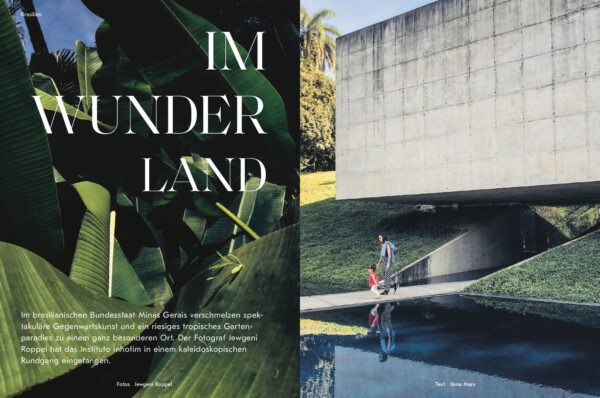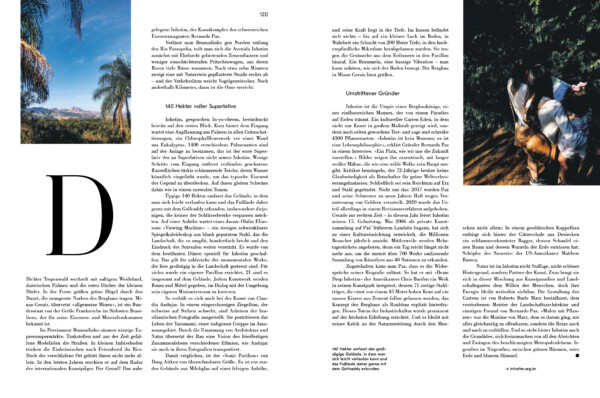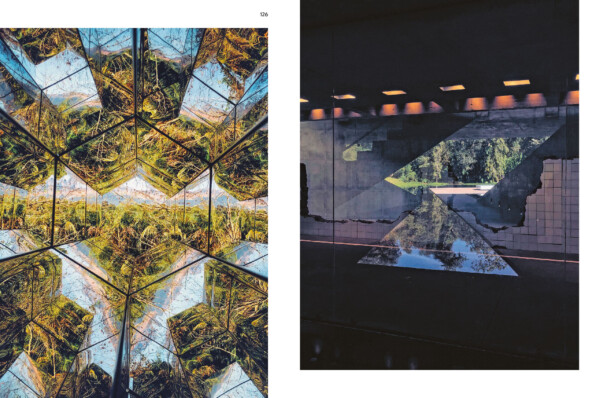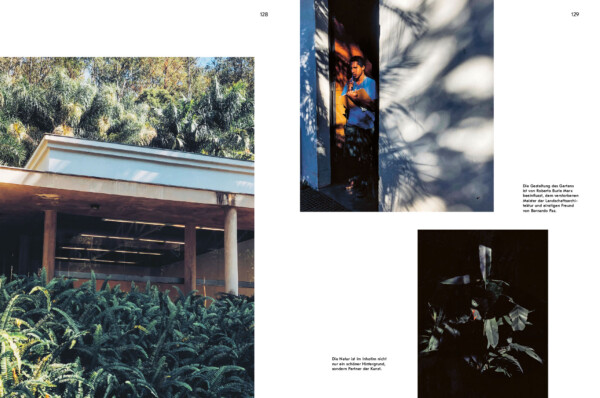Ilona Marx
Editorial work / Concepts / Texts
In wonderland
Art & Culture / Travel
In the Brazilian state of Minas Gerais, spectacular contemporary art and a huge tropical garden paradise merge to create a wholly exceptional place. Photographer Jewgeni Roppel captured Instituto Inhotim during a kaleidoscopic tour.
Dense tropical forest mixes with lush pastureland, in between, palm trees and the red roofs of small villages dot the landscape. In the distance, green hills greet us through the haze, bearing the orange-red scars of mining. Minas Gerais, translated as »general mines,« is a state the size of France in southeastern Brazil, known for its iron ore and mineral deposits.
In the provincial town of Brumadinho, tiny express supermarkets, petrol stations, and out-of-time fashion shops line the streets. The locals drink after-work beers in small snack bars. But the sleepy village no longer belongs to them alone. In recent years, it has appeared on the radar of international art pilgrims. The reason? Nearby is Inhotim, the art complex owned by ultra-wealthy iron ore magnate Bernardo Paz.
Leaving Brumadinho north along the Rio Paraopeba, Avenida Inhotim is initially shared with intimidating cement trucks and less intimidating flatbed trucks with deep bass booming from their speakers. After about ten minutes, a road paved with natural stone branches off to the right — and the noise of traffic gives way to birdsong. Another one and a half kilometres, and the oasis appears.
Inhotim, pronounced In-yo-cheem, impresses from the start. Just beyond the entrance, a plantation of palms in all shades of green awaits, a chlorophyll firework in front of a wall of eucalyptus. There are 1400 different palm species to marvel at on the grounds, which is the first superlative of Inhotim — a place that doesn’t lack superlatives. A few steps from the entrance, shorn lawns connect shimmering turquoise ponds, whose water has been artificially dyed to cover the typical iron red of the area. Swans glide across them as if in a surreal dream.
Covering a lush 140 hectares, it’s easy to get lost on the grounds, so the easy going prefer to explore by golf cart, especially if they don’t want to miss any of the pivotal works. One of them awaits on a hilltop: Olafur Eliasson’s Viewing Machine — a huge swiveling mirror kaleidoscope made of brightly polished steel that refracts the surrounding landscape a hundredfold, further enhancing the impression of the surreal. It was created by the famous Dane especially for Inhotim. This is true for many of the monumental works that are generously scattered throughout the property. Separate pavilions were erected for many of them; there are a total of twenty-one on site. Each work of art is given the space and means to create its own mini-universe in dialogue with its surroundings.
This is also the case with the art of Claudia Andujar. Works by the Brazilian photographer are exhibited in a one-story brick building partially suspended on stilts. They portray the lives of the Yanomami, an indigenous group in the Amazon. By embracing architecture and nature, the building translates a vision of peaceful coexistence between different eth-nic groups, which is also conveyed by Andujar in her photographs. Compared to this, Doug Aitken’s Sonic Pavilion is a more manageable size. It is a round building made of frosted glass on a rocky hill, and its power lies in its depth. There is nothing inside — except for a small hole in the ground, in reality a shaft 200 meters deep, into which highly sensitive microphones have been lowered. They carry the sounds from inside the earth up into the pavilion. A hum, a bassy vibration — you can listen to the ground moving. Mining in Minas Gerais sends its regards.
Inhotim is the utopia of a mining king, an influential man who dreams of paradise on earth. A cultural Garden of Eden, where not only art is displayed on a large scale, but also rare species of animals and a staggering 4300 species of plants. »Inhotim is not a museum, it is a life philosophy,« explains founder Bernardo Paz during an interview. »A place where we imagine the future.« Pictures depict an eccentric, with a long white mane surrounding his head like an errant cloud. Critics charge that the seventy-two-year-old has no credibility as an ambassador for green do-gooder fantasies. After all, they say, his wealth is based on ore and steel. Not only that: In 2017, Paz and his sister were sentenced to nine years in prison for misappropriation of funds, but in 2020 the sentence was overturned in an appeal. Just in time — this year Inhotim celebrates its fifteenth birthday. What began in 2006 as a private art collection at Paz’s former country estate has evolved into a cultural institution that attracts millions of visitors annually. Today, multi-day tickets are offered, because one day is no longer enough to explore the collection, which currently comprises more than 700 works by artists from forty nations.
To Paz’s credit, he admits that there are contradictions in his biography. Thus, with Beam Drop Inhotim by the American Chris Burden, he has integrated a work into his art park whose seventy-one rusty steel girders, dropped from a forty-five-meter-high crane onto a wet cushion of cement, explicitly question the concept of mining as overexploitation. This totem of industrial culture was prominently erected at the park’s highest elevation. And it is not alone in its critique of man’s destruction of nature: in a geodesic dome structure, a mudencrusted excavator, its shovel having snatched a tree and its roots from the earth, is revealed behind a lattice shell of triangles. The scene’s creator: American Matthew Barney.
At Inhotim, nature is not merely an accessory, not a beautiful background, rather, it is a partner to art. Although it bows to the will of man in this combination of art paradise and landscape garden, its energy remains visible. The design of the garden is influenced by Roberto Burle Marx, the late master of landscape architecture and one-time friend of Bernardo Paz. »Painting with plants« was Marx’s maxim. He would never reveal everything at once, but divulge charms little by little. Hence, the basic idea behind Inhotim is to free oneself from all the intentions and constraints of accelerated city life. Somewhere in the middle of nowhere, between green trees, red earth, and blue sky.
The Weekender,
January 2021





